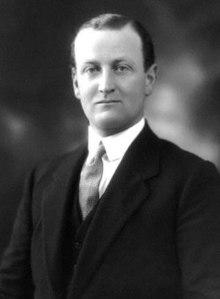George Arthur Boyd-Rochfort
| George Arthur Boyd-Rochfort | |
|---|---|
 |
|
| Born | 1 January 1880 Middleton Park House, County Westmeath, Ireland |
| Died | 7 August 1940 (aged 60) Dublin, Ireland |
| Buried | Castletown Old Churchyard, County Westmeath |
| Allegiance |
|
| Service/branch |
|
| Rank | Captain |
| Unit | Scots Guards |
| Battles/wars | World War I |
| Awards |
|
| Relations | Cecil Boyd-Rochfort (brother) |
George Arthur Boyd-Rochfort VC (1 January 1880 – 7 August 1940) was an Irish recipient of the Victoria Cross, the highest and most prestigious award for gallantry in the face of the enemy that can be awarded to British and Commonwealth forces.
Boyd-Rochfort was born at Middleton Park House, County Westmeath, Ireland on 1 January 1880.
Boyd-Rochfort was 35 years old, and a second lieutenant in the Scots Guards, British Army, (Special Reserve, attached to 1st Battalion) during the First World War when the following deed took place for which he was awarded the VC.
On 3 August 1915 between Cambrin and La Bassée, France, a German trench-mortar bomb landed on the side of the parapet of the communication trench in which Second Lieutenant Boyd-Rochfort was standing close to a small working party of his battalion. Instead of stepping back into safety he shouted to his men to look out, rushed at the bomb, seized it and hurled it over the parapet where it at once exploded. This combination of presence of mind and courage saved the lives of many of the working party.
Boyd-Rochfort later achieved the rank of captain.
Boyd-Rochfort was a noted jockey and after the war become a racehorse trainer like his brother Cecil Boyd-Rochfort. He died at Dublin on 7 August 1940.
His Victoria Cross is displayed at The Guards Regimental Headquarters (Scots Guards RHQ) in Wellington Barracks, London.
Listed in order of publication year
...
Wikipedia
